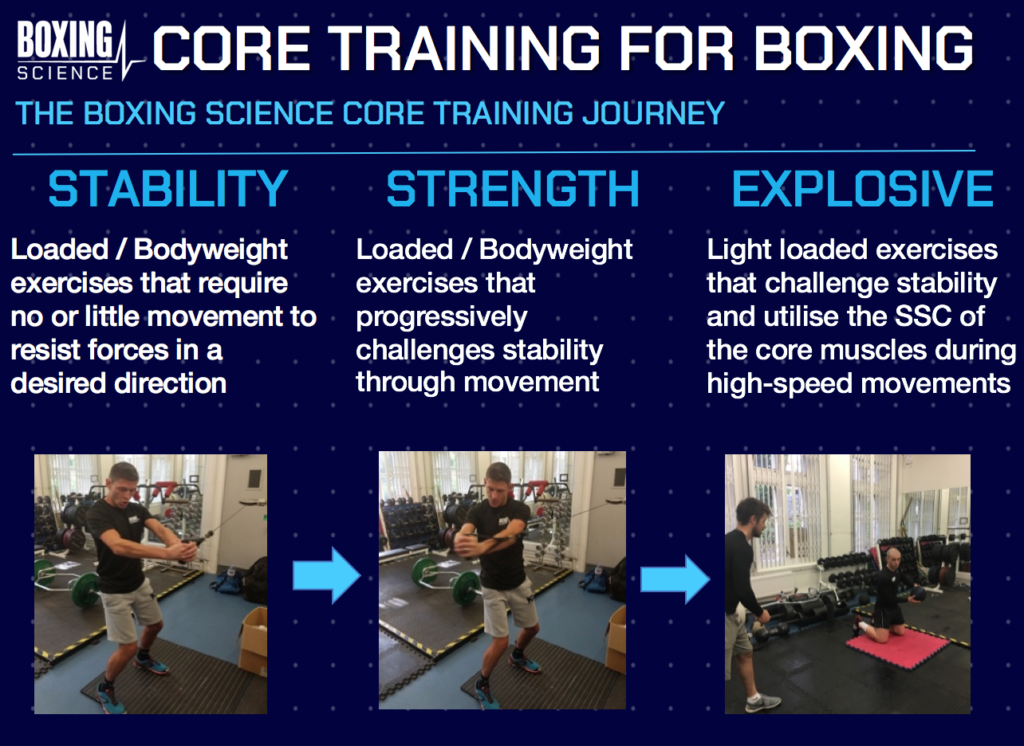Core Training for Boxing
Do you know what one of the most important parts of the body is for developing punch force?
During our research, we’ve found that lean muscle of the core has a large relationship with estimated punching force. More core muscle, especially relative to body size, enabled athletes to perform better in our punch specific test.
But why is the core important? And how do we develop our core to improve the effectiveness of punching?
In this article, we will cover the science behind core training and share our core training philosophy.
Core Training for Boxing and Combat Sports
Whether you’ve seen Golovkin’s crazy 1000 rep ab workout, Mayweather’s Sit Up Routine or Rocky doing all sorts of madness in a training montage, it is well renowned that core training has been an important aspect to a fighters preparation.
But why do we do it?
Core training is an integral part of our training programmes at Boxing Science. This is due to our testing results indicating large correlations between trunk muscle mass and estimated punch force.
This suggests that the stronger your core is, the harder your punch!
However, this can’t be achieved through just through the traditional boxing approach by adding sit ups at the end of your boxing session. Just like in strength training, there needs to be a progressive and systematic approach to core training.
This makes sure the foundations of core stability and strength provide foundations for explosive core training, making the core musculature effective when transferring force through the kinetic chain whilst punching.
Stronger Core = Harder Punch
At Boxing Science, we pride ourselves on our testing battery and scientific research. Part of this research was to find the biggest physical contributor to a punch to help inform our training philosophy and programming.
A big part of our testing is a body composition assessment – we use the InBody bioelectrical impendence analyser to assess body fat and muscle mass.
This is important so we can accurately assess a boxers condition when making weight, and also what weight category a boxer should perform at.

Furthermore, the Inbody machine provides a segmental analysis of how muscle mass is distributed around the body – the arms, lower-body and trunk.
When analysing the data, we found that absolute and relative trunk muscle mass had the biggest contribution to medicine ball punch distance. Suggesting that core mass and strength has a positive contribution to punch force.
This means that developing core mass and strength is a key aim of our programme. Also when making weight, we aim to maintain muscle mass of the core to ensure our athletes are in the optimal condition when they step on to the scales.
We can develop this through compound lifts, partial range exercises and core specific exercises.
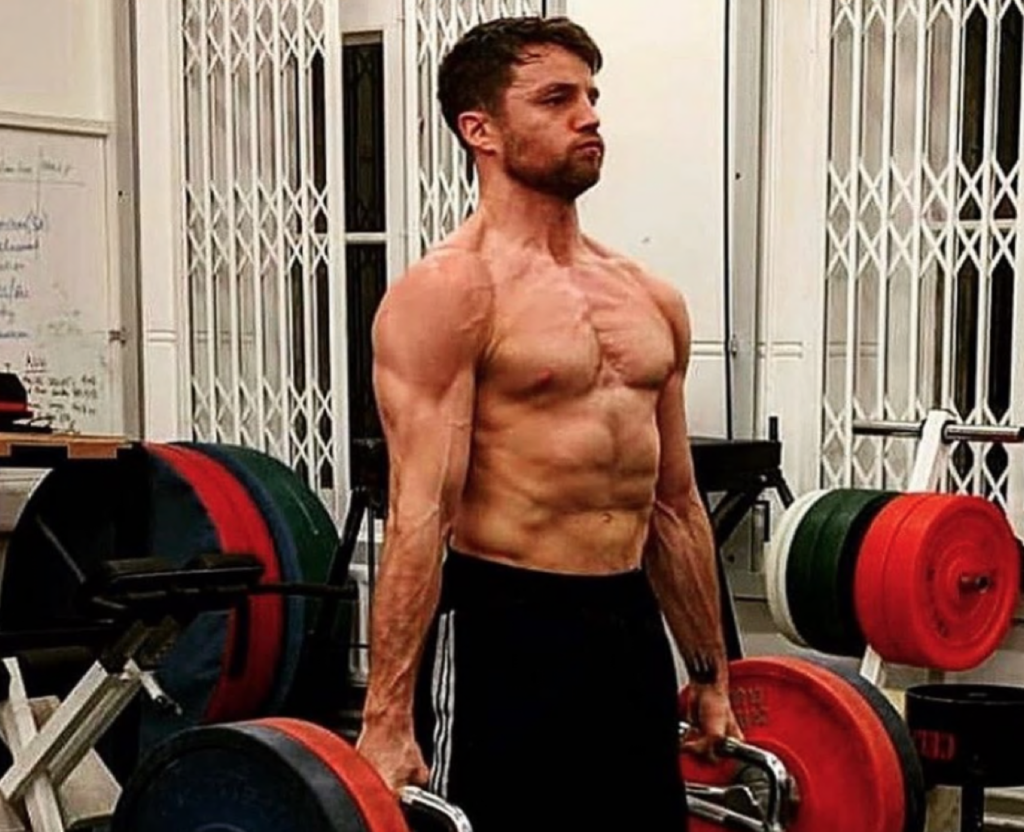
The Kinetic Chain
The reason why core strength contributes to a forceful punch because it links the lower and upper body in the Kinetic chain.
The Kinetic Chain is a term used to describe how force is transferred through different parts of the body to produce movement. In punching, force is transferred from the lower-body through to the first.
The core muscles are a vital link between lower- and upper-body, and help transfer force during punching actions. The amount of speed and force that can be transferred relies on the stretch-shortening cycle of the core muscles – this is how quickly and effectively muscles can absorb and re-produce force.
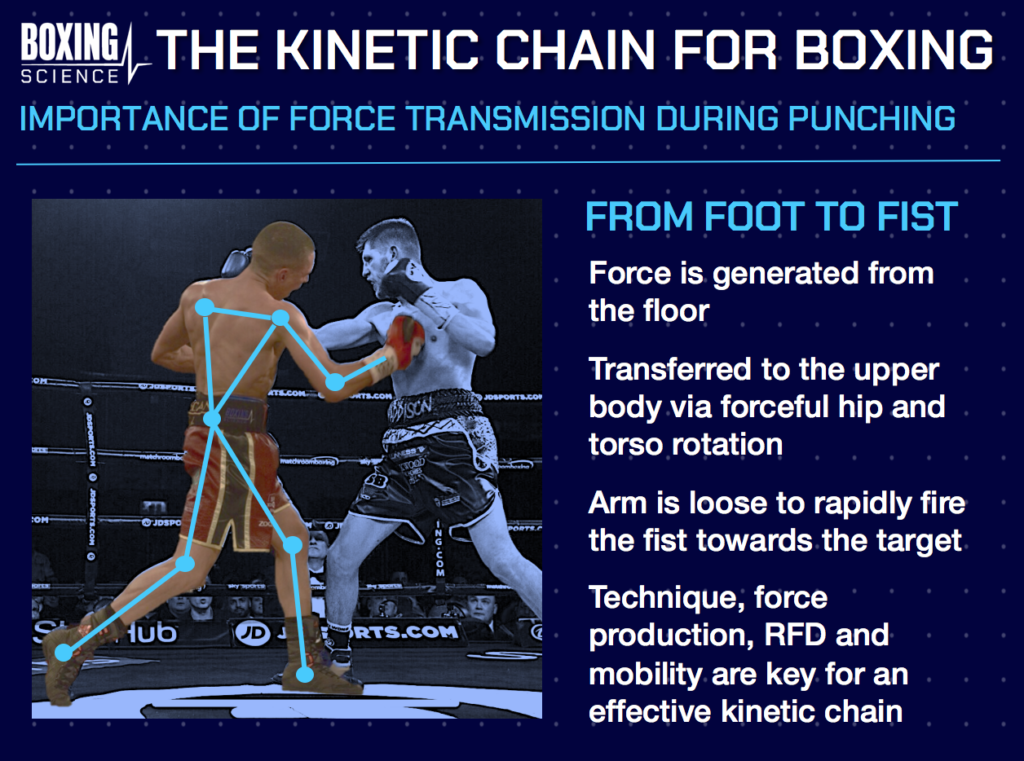
This is the most important attribute and role that the core muscles play during punching…. In particular combination punching.
Think about the action of the core during a back hand, lead hook combination…. The trunk and upper body has to decelerate from the back hand, then rapidly re-produce force into the lead hook.
Core Strength Contributes To Effective Mass
Core strength also plays an important role in generating effective mass, this is known as the ‘snap’ of a punch. This requires the whole body to stiffen up upon impact. The snap requires whole body tension, however, the main contributors are the arms, shoulder joint and the core.
The core’s role is to create the tension for more body mass to contribute to the punch. If the core doesn’t tense during impact, the force is absorbed through the arm and won’t be as forceful.
The ability to tense upon impact takes years and years of practice. However, it’s much easier and quicker to make physical adaptations to help improve punch force.

Isometric Holds
This isn’t just a great way to condition your core, but this exercise can help add snap to your punches.
During the punch, there is a double-activation pattern that requires a whole-body stiffening upon impact. This can be improved through isometric training.
Core Training Helps Reduce Likelihood of Injury
From an injury prevention perspective, the trunk is put under stress through high force / speed movements and large training loads.
This often creates extra training stress to the lower-back, causing tightness and injuries.
We cover a range of core exercises that can help prevent injury in our coaching workshop ‘Mobilise, Stabilise, Strengthen – The Back”
This is available in our Boxing Science Membership
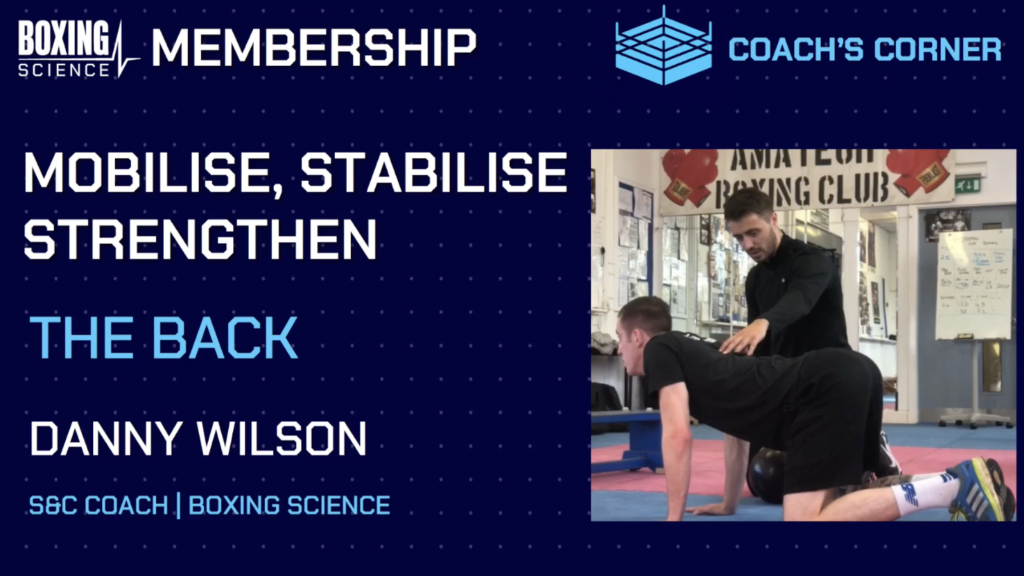
How To Train The Core
The most effective way to increase core strength is to load whole body compound lifts (squats, deadlifts etc) to develop core strength. However, isolated core training also needs to be used to ensure correct recruitment patterns when lifting and training.
We love Dan John’s view on core training … or overall training.
A + B + little bit of C = D
A = Upper body exercise e.g. Bench Press, Pull Up
B = Whole body movement e.g. Deadlift, Squat
C = Core work
D = Your goal … ultimate strength, athletic performance or lean body mass
The main point of this is that if you take away C .. A and B go to pot, therefore effecting the outcome .. D.
So in this article, our focus is on making that little bit of C as effective as possible.
Muscles That Make Up the Core
As previously mentioned the core is much more than developing your abs,however here are some of the main muscles worked when during your core exercises:
Abdominal Muscles – Rectus Abdominus, Tranverse Abdominus
Back Muscles – Spinal Erectors, Multifidi
The Lateral Stabilizers – Quadratus Lumborum, Internal and External Obliques
Movements of the Core
There are four movements of the core, flexion, extension, lateral flexion and rotation.
However, if these movements become excessive the core will crumble and we may cause technique faults or injury. Here are a couple of theoretical examples…
Excessive rotation during combinations could affect angle of attack or defensive position
Lack of strength decreases stretch-shortening of the core muscles, therefore less punch force produced.
Therefore we need to resist these movements, hence the fundamentals of core training set by American strength coach Mike Robertson.
21st Century Core Training
Here are the four different areas of core training for boxing. We incorporate these exercise types 2-3 times each per week, and select different exercises on stability, strength and explosiveness dependant on the training phase.

Anti-Rotation
What is it? Actively resisting rotation of the lumbar spine.
Why is it good for boxing? Stronger rotation during punches due to use of stretch shortening cycle when performing combinations.
Exercise examples: Pallof Press (pictured), Landmine Rotations.
Anti-Extension
What is it? Actively resisting extension of the lumbar spine.
Why is it good for boxing? To protect the back when performing large amounts of punching activities during training.
Exercise examples: Barbell Rollouts (pictured), Plank
Anti-Lateral Flexion
What is it? Resisting lateral flexion of the lumbar spine
Why is it good for boxing? Allows a boxer to punch without side bending, then to recover when rotating back for combos or head movement.
Exercise examples: Landmine rotations (pictured), Suitcase Deadlift, Side Plank.
Hip Flexion with a Neutral Spine
What is it? Bracing the core to create a controlled flexion at the hip without flexing the spine
Why is it good for boxing? Resisting forward lean when attacking or moving forward.
Exercise examples: Deadbugs, Straight leg sit ups, Iso holds (pictured).
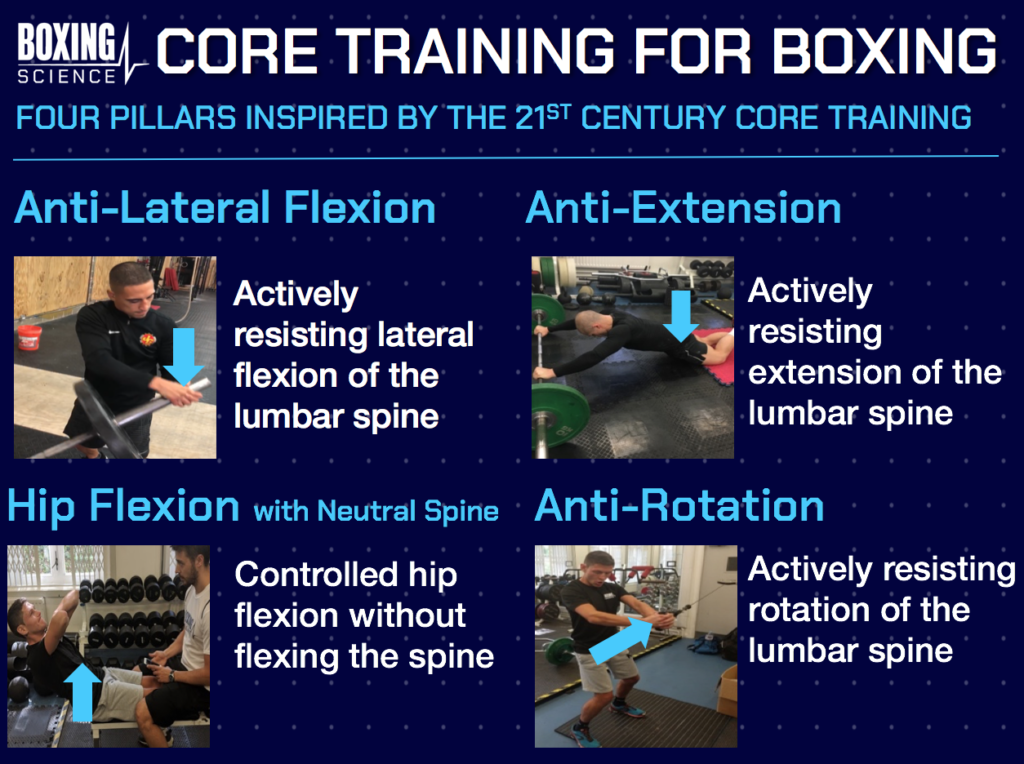
“How Often Should I Do Core Training?”
In our programming, we ensure that we include the four different areas of core training are trained 3-4 times per week.
We incorporate the heavy load / dynamic exercises during strength sessions twice per week. This is done through single, super-set or 3 station circuits towards the end of their workout.
Then athletes are given a selection of bodyweight exercises to do as a circuit following boxing, conditioning or active recovery sessions.
In a 8-12 week training camp for our more advanced athletes, we would periodise core training just like our strength training … working on core strength at first before progressing to more explosive core training in speed-strength / tapering training phases.

Progressing Core Training
As we mentioned earlier in the article. Our end goal is to improve the stretch-shortening cycle of the core to transfer to high-speed, high-force punching actions.
This can be developed through explosive core training, such as medicine ball throws.
However, an athlete needs to build the foundations of core strength and stability so they can absorb force effectively. If the core struggles to do this, it will affect the ability to re-produce force into a punching action. The graphic above outlines our core training philosophy.
If you would like to know more, you must check out our subscription service where you can access our core training workshop, and all of our core exercises in our exercise library. Here is an example below….
Summary of Core Training
Core training should be a staple part of a boxers training programme. It should be performed 3-5 x per week, preferably at the end of boxing or strength training sessions, or as a movement filler.
When training the core, perform 2-3 sets of 6-12 reps per exercise. We often put 2-3 exercises together as part of a core training circuit with our boxers.
To begin with, we use bodyweight stability exercises to build solid foundations for core training (e.g. Plank Row).
We then begin to add external loads such as dumbbells / kettlebells to provide an overload stimulus, training the strength of the core (e.g. Landmine Rotations).
Closer to a fight, we’ll use explosive core exercises. We often use medicine ball throws to challenge the stretch-shortening cycle of the core to help build explosive strength and speed (e.g. MB Rotational Throws)
